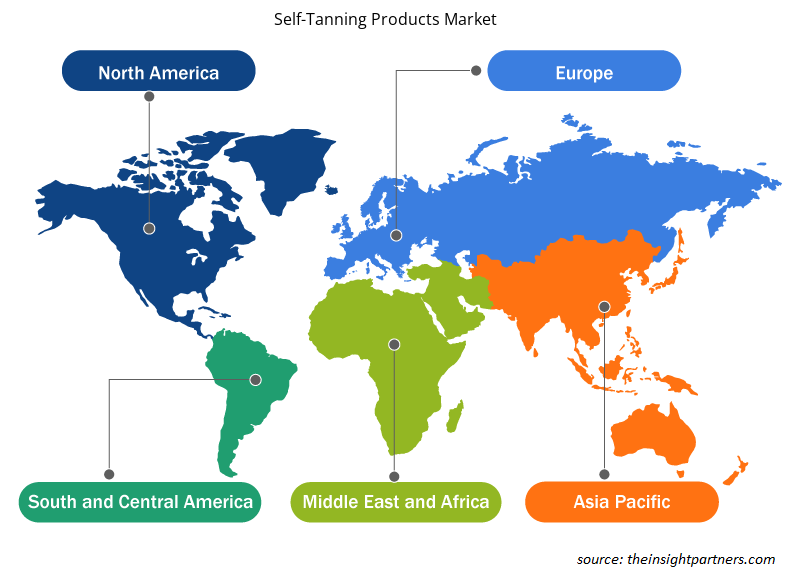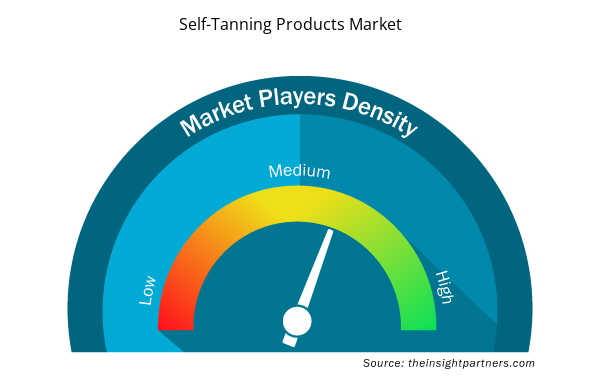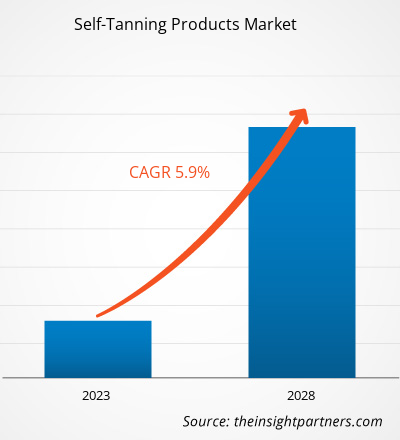Der Markt für Selbstbräunungsprodukte soll von 1.078,36 Millionen US-Dollar im Jahr 2022 auf 1.519,59 Millionen US-Dollar im Jahr 2028 wachsen; von 2022 bis 2028 wird eine durchschnittliche jährliche Wachstumsrate (CAGR) von 5,9 % erwartet.
Selbstbräunungsprodukte, auch Selbstbräunungsprodukte oder künstliche Bräunungsmittel genannt, werden verwendet, um einen gebräunten oder bronzefarbenen Hautton zu erhalten, ohne der Haut direkte Sonneneinstrahlung zuzuführen. Die schädlichen UV-Strahlen des Sonnenlichts können Hautschäden verursachen und das Risiko von Hautkrebs erhöhen. Dieser Faktor treibt die Nachfrage nach Selbstbräunungsprodukten erheblich an. Darüber hinaus wird erwartet, dass die steigende Zahl gebräunter Prominenter die Akzeptanz von Selbstbräunungsprodukten, insbesondere bei jungen Verbrauchern, steigern wird.
Im Jahr 2021 hatte Europa den größten Anteil am weltweiten Markt für Selbstbräunungsprodukte . Die sich ändernden Trends im Lebensstil und in der Hautpflege der Verbraucher treiben den Markt für Selbstbräunungsprodukte in Europa an. Die Wellnessbranche in der Region passt sich allmählich den sich entwickelnden Verbraucherpräferenzen wie Bio- und Naturprodukten an. Daher verwenden Hersteller zunehmend natürliche Inhaltsstoffe, um Selbstbräunungsprodukte zu entwickeln. Diese Faktoren beeinflussen den Markt für Selbstbräunungsprodukte. Darüber hinaus wird erwartet, dass der wachsende Trend zu einer natürlichen und strahlenden Bräune, insbesondere bei jungen Erwachsenen, den Verkauf von Selbstbräunungsprodukten im Prognosezeitraum ankurbeln wird.
Passen Sie diesen Bericht Ihren Anforderungen an
Sie erhalten kostenlose Anpassungen an jedem Bericht, einschließlich Teilen dieses Berichts oder einer Analyse auf Länderebene, eines Excel-Datenpakets sowie tolle Angebote und Rabatte für Start-ups und Universitäten.
- Holen Sie sich die wichtigsten Markttrends aus diesem Bericht.Dieses KOSTENLOSE Beispiel umfasst eine Datenanalyse von Markttrends bis hin zu Schätzungen und Prognosen.
Auswirkungen der COVID-19-Pandemie auf den Markt für Selbstbräunungsprodukte
Die COVID-19-Pandemie hatte gemischte Auswirkungen auf den Markt für Selbstbräunungsprodukte, insbesondere im Jahr 2020. Selbstbräunungsprodukte wurden von den Regierungen mehrerer Länder nicht als lebensnotwendige Produkte eingestuft, was die Hersteller dazu zwang, die Produktion dieser Produkte einzustellen. Während der Krise erlebten Dienstleister im Sonnenstudiobereich aufgrund der geringeren Nachfrage nach Bräunungsprodukten einen massiven Rückschlag. Allerdings löste die COVID-19-Pandemie in vielen Branchen eine digitale Transformation aus, darunter auch in der Kosmetik- und Körperpflegebranche. Laut von Bluecore veröffentlichten Daten wurde im Juni 2020 beim Online-Verkauf von Schönheits- und Hautpflegeprodukten weltweit ein durchschnittlicher Anstieg von 127 % im Vergleich zum gleichen Monat im Jahr 2019 gemeldet. Ebenso meldete L’Oréal , dass seine Umsätze über Online-Kanäle von 15,6 % im Jahr 2019 auf 26,6 % im Jahr 2020 gestiegen sind. Diese Faktoren zeigen die gemischten Auswirkungen der Pandemie auf den Markt für Selbstbräunungsprodukte.
Im Jahr 2021 nahmen verschiedene Volkswirtschaften ihren Betrieb wieder auf, als ihre Regierungen Lockerungen der zuvor verhängten Beschränkungen ankündigten, was den globalen Markt ankurbelte. Darüber hinaus durften die Hersteller mit voller Kapazität arbeiten, was ihnen half, die Lücke zwischen Angebot und Nachfrage sowie andere Auswirkungen zu überwinden. Derzeit ist die Marktlage stabil und die Hersteller bauen ihre Präsenz auf Online-Einzelhandelsplattformen wie Amazon.com , Shopify , Walmart und eBay aus, um ihre Umsätze anzukurbeln. Dieser Faktor dürfte das Wachstum des Marktes für Selbstbräunungsprodukte im Prognosezeitraum vorantreiben.
Markteinblicke
Wachstum der globalen Kosmetikindustrie
In jüngster Zeit hat das Bewusstsein für Gesundheit und Hautpflege weltweit deutlich zugenommen. Die zunehmende Entwicklung nachhaltiger Kosmetika, Werbestrategien und innovativer Produktmarken sind die Hauptfaktoren für die Etablierung der Kosmetikindustrie. Auch die zunehmenden gesundheitlichen Bedenken hinsichtlich Hautkrankheiten und anderer Gesundheitsrisiken im Zusammenhang mit Umwelt- und Sonneneinstrahlung haben die Nachfrage nach Kosmetikprodukten erhöht. Immer mehr Frauen integrieren Pflegeprodukte in ihre tägliche Routine. Der Kosmetikmarkt in Europa und Nordamerika ist gut etabliert, während die Kosmetikindustrie im asiatisch-pazifischen Raum sowie im Nahen Osten und Afrika stark wächst. Mit der steigenden Zahl von Produkteinführungen können Verbraucher aus mehreren auf dem Markt verfügbaren Marken wählen. Laut den im Jahresbericht 2020 von L'Oréal veröffentlichten Daten verzeichneten die globalen Schönheitsmärkte im Jahr 2019 eine Wachstumsrate von 8 %. Die steigenden Ausgaben für Schönheitsprodukte tragen also zum Wachstum der globalen Kosmetikindustrie bei. Selbstbräunungsprodukte werden immer beliebter, da die Menschen bronzefarbene und gebräunte Hauttöne mögen. Außerdem sind diese Produkte bequem in der Anwendung, da sie den gewünschten Hautton ohne Sonneneinstrahlung und Sonnenschäden verleihen. Daher treiben das Wachstum der Kosmetikindustrie weltweit und die zunehmende Verwendung von Selbstbräunern den Markt für Selbstbräunungsprodukte an.
Produkttypbasierte Einblicke
Basierend auf dem Produkttyp ist der globale Markt für Selbstbräunungsprodukte in Creme & Lotion, Serum, Nebel und andere unterteilt. Das Segment Creme & Lotion hatte 2021 den größten Anteil am globalen Markt für Selbstbräunungsprodukte; das Nebelsegment dürfte jedoch von 2022 bis 2028 die höchste durchschnittliche jährliche Wachstumsrate verzeichnen . Ein Selbstbräunungsnebel enthält eine Bräunungsformel auf Wasserbasis, was die Anwendung erleichtert. Er besteht aus einem 360-Grad-Weitwinkel-Strahlapplikator, der das Produkt vollständig aufträgt und gleichmäßig über das Gesicht verteilt und aufgrund seiner leichten Konsistenz sofort trocknet. Kunden bevorzugen Selbstbräunungsnebel auch zum Auffrischen. Aufgrund des Hauptvorteils seiner problemlosen Anwendung gewinnt das Nebelsegment daher bei vielen Verbrauchern auf der ganzen Welt an Beliebtheit.
Einblicke basierend auf Vertriebskanälen
Basierend auf den Vertriebskanälen ist der globale Markt für Selbstbräunungsprodukte in Supermärkte und Hypermärkte, Convenience Stores, Online-Einzelhandel und andere unterteilt. Das Segment Supermärkte und Hypermärkte hielt 2021 den größten Anteil am globalen Markt für Selbstbräunungsprodukte; jedoch wird erwartet, dass das Segment Online-Einzelhandel von 2022 bis 2028 die höchste CAGR verzeichnet . Online-Einzelhandelsgeschäfte bieten verschiedene Produkte mit hohen Rabatten an. Außerdem können Verbraucher gewünschte Produkte bequem aus der Ferne kaufen. Darüber hinaus ziehen Hauslieferdienste eine große Gruppe von Kunden an, die über E-Commerce -Plattformen wie Amazon.com , Walmart und E-bay einkaufen. Außerdem bieten diese Websites ausführliche Produktinformationen und Nutzerbewertungen, die Käufern helfen, Produkte zu vergleichen und fundierte Entscheidungen zu treffen. Während der COVID-19-Pandemie wurden Online-Einzelhandelskanäle populär, da sie Hauslieferdienste anboten. Aufgrund all dieser Faktoren ist der Online-Einzelhandel einer der am schnellsten wachsenden Vertriebskanäle.
Zu den Akteuren auf dem globalen Markt für Selbstbräunungsprodukte gehören Bondi Sands Pty Ltd, KAO Corp, PZ Cussons Plc, Supernova UK Pty Ltd, Epic Etailers LLC, Loreal SA, HotHouse Beauty Ltd, Johnson & Johnson, Coty Inc und Edgewell Personal Care Co. Die Marktteilnehmer konzentrieren sich darauf, qualitativ hochwertige Produkte anzubieten, um die Kundennachfrage zu erfüllen. Sie konzentrieren sich auch auf Strategien wie Investitionen in Forschungs- und Entwicklungsaktivitäten sowie Fusionen und Übernahmen.
Bericht-Spotlights
- Fortschrittliche Branchentrends auf dem Markt für Selbstbräunungsprodukte helfen den Akteuren bei der Entwicklung wirksamer langfristiger Strategien
- Von Industrie- und Entwicklungsländern übernommene Strategien für Unternehmenswachstum
- Quantitative Analyse des Marktes für Selbstbräunungsprodukte von 2020 bis 2028
- Schätzung der weltweiten Nachfrage nach Selbstbräunungsprodukten
- PEST-Analyse zur Veranschaulichung der politischen, wirtschaftlichen, sozialen und technologischen Faktoren, die das globale Marktwachstum für Selbstbräunungsprodukte beeinflussen.
- Aktuelle Entwicklungen zum Verständnis des Wettbewerbsmarktszenarios
- Markttrends und -aussichten sowie Faktoren, die das Wachstum des Marktes für Selbstbräunungsprodukte vorantreiben und bremsen
- Unterstützung im Entscheidungsprozess durch Aufzeigen von Marktstrategien, die das kommerzielle Interesse untermauern und zum Marktwachstum führen
- Marktgröße für Selbstbräunungsprodukte an verschiedenen Knotenpunkten
- Detaillierte Übersicht und Segmentierung des Marktes sowie der Branchendynamik der Selbstbräunungsprodukte
- Größe des Marktes für Selbstbräunungsprodukte in verschiedenen Regionen mit vielversprechenden Wachstumschancen
Regionale Einblicke in den Markt für Selbstbräunungsprodukte
Die regionalen Trends und Faktoren, die den Markt für Selbstbräunungsprodukte während des Prognosezeitraums beeinflussen, wurden von den Analysten von Insight Partners ausführlich erläutert. In diesem Abschnitt werden auch die Marktsegmente und die Geografie für Selbstbräunungsprodukte in Nordamerika, Europa, im asiatisch-pazifischen Raum, im Nahen Osten und Afrika sowie in Süd- und Mittelamerika erörtert.

- Erhalten Sie regionale Daten zum Markt für Selbstbräunungsprodukte
Umfang des Marktberichts zu Selbstbräunungsprodukten
| Berichtsattribut | Details |
|---|---|
| Marktgröße im Jahr 2022 | 1,08 Milliarden US-Dollar |
| Marktgröße bis 2028 | 1,52 Milliarden US-Dollar |
| Globale CAGR (2022 - 2028) | 5,9 % |
| Historische Daten | 2020-2021 |
| Prognosezeitraum | 2023–2028 |
| Abgedeckte Segmente | Nach Produkttyp
|
| Abgedeckte Regionen und Länder | Nordamerika
|
| Marktführer und wichtige Unternehmensprofile |
|
Dichte der Marktteilnehmer für Selbstbräunungsprodukte: Die Auswirkungen auf die Geschäftsdynamik verstehen
Der Markt für Selbstbräunungsprodukte wächst rasant, angetrieben von der steigenden Nachfrage der Endverbraucher aufgrund von Faktoren wie sich entwickelnden Verbraucherpräferenzen, technologischen Fortschritten und einem größeren Bewusstsein für die Vorteile des Produkts. Mit steigender Nachfrage erweitern Unternehmen ihr Angebot, entwickeln Innovationen, um die Bedürfnisse der Verbraucher zu erfüllen, und nutzen neue Trends, was das Marktwachstum weiter ankurbelt.
Die Marktteilnehmerdichte bezieht sich auf die Verteilung der Firmen oder Unternehmen, die in einem bestimmten Markt oder einer bestimmten Branche tätig sind. Sie gibt an, wie viele Wettbewerber (Marktteilnehmer) in einem bestimmten Marktraum im Verhältnis zu seiner Größe oder seinem gesamten Marktwert präsent sind.
Die wichtigsten auf dem Markt für Selbstbräunungsprodukte tätigen Unternehmen sind:
- Bondi Sands Pty Ltd
- KAO Corp
- PZ Cussons Plc
- Supernova UK Pty Ltd
- Epic Etailers LLC
Haftungsausschluss : Die oben aufgeführten Unternehmen sind nicht in einer bestimmten Reihenfolge aufgeführt.

- Überblick über die wichtigsten Akteure auf dem Markt für Selbstbräunungsprodukte
Firmenprofile
- Bondi Sands Pty Ltd Sands Pty Ltd
- KAO Corp Corp
- PZ Cussons Plc Cussons Plc
- Supernova UK Pty Ltd
- Epic Etailers LLCEtailers LLC
- Loreal SA SA
- HotHouse Beauty GmbH Beauty Ltd
- Johnson & Johnson
- Coty Inc Inc
- Edgewell Körperpflege Co Personal Care Co
- Historische Analyse (2 Jahre), Basisjahr, Prognose (7 Jahre) mit CAGR
- PEST- und SWOT-Analyse
- Marktgröße Wert/Volumen – Global, Regional, Land
- Branche und Wettbewerbsumfeld
- Excel-Datensatz



Report Coverage
Revenue forecast, Company Analysis, Industry landscape, Growth factors, and Trends

Segment Covered
This text is related
to segments covered.

Regional Scope
North America, Europe, Asia Pacific, Middle East & Africa, South & Central America

Country Scope
This text is related
to country scope.
Häufig gestellte Fragen
Well-established global cosmetics and personal care industry coupled with increasing strategic initiatives by key players operating in the self-tanning products market are driving the market growth.
Based on distribution channel, the online retail segment is projected to grow at the fastest CAGR over the forecast period. Rapid growth of e-commerce due to the convenience of shopping a variety of products remotely and attractive offers and discounts are driving the segment’s growth
Based on product type, the cream & lotion segment mainly has the largest revenue share. Creams and lotions are easy to apply, provides hydration, spread evenly, and are available across various small as well as large retail stores. These factors are driving the segment’s growth.
Europe accounted for the largest share of the global self-tanning products market. Europe has well-established cosmetic and personal care industry. Consumers have access to a wide range of brands of self-tanning products due to the presence of strong retail infrastructure. Moreover, there is a high influence of celebrities and social media trends on lifestyle of consumers. All these factors are driving the growth of self-tanning products market across Europe
Rising popularity of natural & organic self-tanning products due to shifting preference towards chemicals-free, herbal, and all-natural personal care products can provide lucrative growth opportunities to the self-tanning products market.
The major players operating in the global self-tanning products market are Bondi Sands Pty Ltd, KAO Corp, PZ Cussons Plc, Supernova UK Pty Ltd, Epic Etailers LLC, Loreal SA, HotHouse Beauty Ltd, Johnson & Johnson, Coty Inc, and Edgewell Personal Care Co
Trends and growth analysis reports related to Consumer Goods : READ MORE..
The List of Companies - Self-Tanning Products Market
- Bondi Sands Pty Ltd
- KAO Corp
- PZ Cussons Plc
- Supernova UK Pty Ltd
- Epic Etailers LLC
- Loreal SA
- HotHouse Beauty Ltd
- Johnson & Johnson
- Coty Inc
- Edgewell Personal Care Co
The Insight Partners performs research in 4 major stages: Data Collection & Secondary Research, Primary Research, Data Analysis and Data Triangulation & Final Review.
- Data Collection and Secondary Research:
As a market research and consulting firm operating from a decade, we have published and advised several client across the globe. First step for any study will start with an assessment of currently available data and insights from existing reports. Further, historical and current market information is collected from Investor Presentations, Annual Reports, SEC Filings, etc., and other information related to company’s performance and market positioning are gathered from Paid Databases (Factiva, Hoovers, and Reuters) and various other publications available in public domain.
Several associations trade associates, technical forums, institutes, societies and organization are accessed to gain technical as well as market related insights through their publications such as research papers, blogs and press releases related to the studies are referred to get cues about the market. Further, white papers, journals, magazines, and other news articles published in last 3 years are scrutinized and analyzed to understand the current market trends.
- Primary Research:
The primarily interview analysis comprise of data obtained from industry participants interview and answers to survey questions gathered by in-house primary team.
For primary research, interviews are conducted with industry experts/CEOs/Marketing Managers/VPs/Subject Matter Experts from both demand and supply side to get a 360-degree view of the market. The primary team conducts several interviews based on the complexity of the markets to understand the various market trends and dynamics which makes research more credible and precise.
A typical research interview fulfils the following functions:
- Provides first-hand information on the market size, market trends, growth trends, competitive landscape, and outlook
- Validates and strengthens in-house secondary research findings
- Develops the analysis team’s expertise and market understanding
Primary research involves email interactions and telephone interviews for each market, category, segment, and sub-segment across geographies. The participants who typically take part in such a process include, but are not limited to:
- Industry participants: VPs, business development managers, market intelligence managers and national sales managers
- Outside experts: Valuation experts, research analysts and key opinion leaders specializing in the electronics and semiconductor industry.
Below is the breakup of our primary respondents by company, designation, and region:

Once we receive the confirmation from primary research sources or primary respondents, we finalize the base year market estimation and forecast the data as per the macroeconomic and microeconomic factors assessed during data collection.
- Data Analysis:
Once data is validated through both secondary as well as primary respondents, we finalize the market estimations by hypothesis formulation and factor analysis at regional and country level.
- Macro-Economic Factor Analysis:
We analyse macroeconomic indicators such the gross domestic product (GDP), increase in the demand for goods and services across industries, technological advancement, regional economic growth, governmental policies, the influence of COVID-19, PEST analysis, and other aspects. This analysis aids in setting benchmarks for various nations/regions and approximating market splits. Additionally, the general trend of the aforementioned components aid in determining the market's development possibilities.
- Country Level Data:
Various factors that are especially aligned to the country are taken into account to determine the market size for a certain area and country, including the presence of vendors, such as headquarters and offices, the country's GDP, demand patterns, and industry growth. To comprehend the market dynamics for the nation, a number of growth variables, inhibitors, application areas, and current market trends are researched. The aforementioned elements aid in determining the country's overall market's growth potential.
- Company Profile:
The “Table of Contents” is formulated by listing and analyzing more than 25 - 30 companies operating in the market ecosystem across geographies. However, we profile only 10 companies as a standard practice in our syndicate reports. These 10 companies comprise leading, emerging, and regional players. Nonetheless, our analysis is not restricted to the 10 listed companies, we also analyze other companies present in the market to develop a holistic view and understand the prevailing trends. The “Company Profiles” section in the report covers key facts, business description, products & services, financial information, SWOT analysis, and key developments. The financial information presented is extracted from the annual reports and official documents of the publicly listed companies. Upon collecting the information for the sections of respective companies, we verify them via various primary sources and then compile the data in respective company profiles. The company level information helps us in deriving the base number as well as in forecasting the market size.
- Developing Base Number:
Aggregation of sales statistics (2020-2022) and macro-economic factor, and other secondary and primary research insights are utilized to arrive at base number and related market shares for 2022. The data gaps are identified in this step and relevant market data is analyzed, collected from paid primary interviews or databases. On finalizing the base year market size, forecasts are developed on the basis of macro-economic, industry and market growth factors and company level analysis.
- Data Triangulation and Final Review:
The market findings and base year market size calculations are validated from supply as well as demand side. Demand side validations are based on macro-economic factor analysis and benchmarks for respective regions and countries. In case of supply side validations, revenues of major companies are estimated (in case not available) based on industry benchmark, approximate number of employees, product portfolio, and primary interviews revenues are gathered. Further revenue from target product/service segment is assessed to avoid overshooting of market statistics. In case of heavy deviations between supply and demand side values, all thes steps are repeated to achieve synchronization.
We follow an iterative model, wherein we share our research findings with Subject Matter Experts (SME’s) and Key Opinion Leaders (KOLs) until consensus view of the market is not formulated – this model negates any drastic deviation in the opinions of experts. Only validated and universally acceptable research findings are quoted in our reports.
We have important check points that we use to validate our research findings – which we call – data triangulation, where we validate the information, we generate from secondary sources with primary interviews and then we re-validate with our internal data bases and Subject matter experts. This comprehensive model enables us to deliver high quality, reliable data in shortest possible time.


 Holen Sie sich ein kostenloses Muster für diesen Bericht
Holen Sie sich ein kostenloses Muster für diesen Bericht